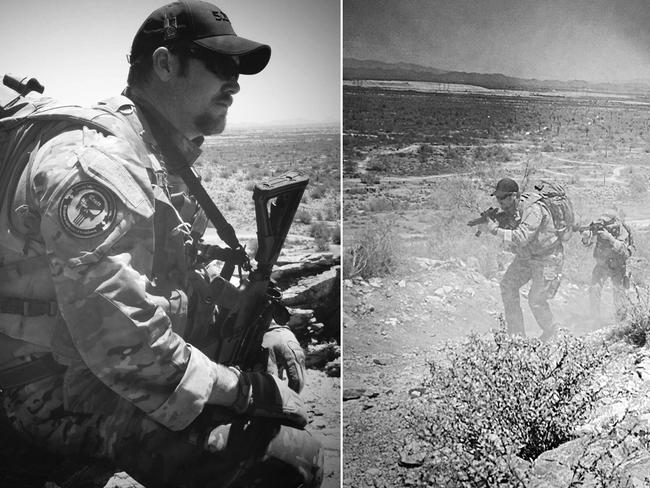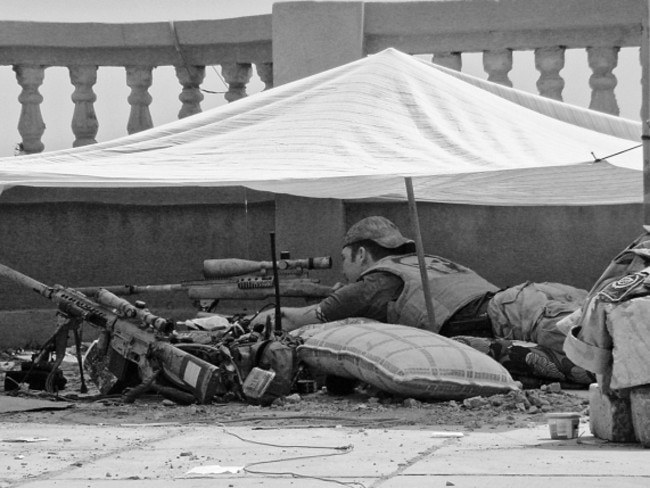The Navy SEAL who became the real-life Jason Bourne
CHRIS Kyle was the deadliest sniper in US military history - so deadly that he’s about to become the subject of a Hollywood blockbuster.

Upcoming Movies
Don't miss out on the headlines from Upcoming Movies. Followed categories will be added to My News.
With 160 confirmed kills, Chris Kyle was the deadliest sniper in US military history — and is the subject of a buzzed-about new film, “American Sniper,” starring Bradley Cooper as Kyle and directed by Clint Eastwood.
Kyle was killed in 2013 by a fellow veteran at a shooting range, although a new book,“Modern American Snipers,” by Chris Martin tells the history of these special warriors and how technology and skill produced a soldier who could shoot someone from a mile away. In this excerpt, he explains Kyle’s success — and reveals the one person who got the best of him.

Word of Chris Kyle’s accomplishments had just started filtering through the usual SEAL channels, but his status as an emerging historical figure was still largely unknown. However, one SEAL officer was keenly aware of what the big Texan had been up to.
The last time Lt. Larry Yatch had seen Kyle, he was just another new guy on his first deployment. He wasn’t “the Legend” at that point. If anything, he had been rather unremarkable, although that was considered a positive in itself because it meant he hadn’t done anything terribly boneheaded to draw attention to himself as new guys tend to do.
Now Yatch noticed Kyle’s mounting success in Iraq. What he observed astonished him.
“I spent a lot of time reading the intel traffic,” the SEAL officer said. “I remember very vividly reading all of those after-action reports and just being amazed.”
The macabre statistics alone were undeniable. “You’d read that he’d had 19 confirmed kills in a 24-hour period. It was almost unbelievable.”
Real-life Jason Bourne

When it came time to select an all-star team of operators for advanced training, Yatch was quick to recruit Kyle.
In 2005, Kyle, then 31, was sent to New Orleans, where he learned basic electronics and the finer points of building and using covert camera systems. He was taught how to conduct countersurveillance, both on foot and in vehicles, along with surreptitious entry — picking locks and “borrowing” other people’s cars when necessary (for example, to successfully complete his training).
His training was now loosely akin to what the real-world realisation of the Hollywood fantasy that is James Bond or Jason Bourne might be — well, with a thick Texas drawl anyway.
Despite the new assortment of skills, Kyle’s focus immediately snapped back into sniper mode when he redeployed in 2006. And he was presented with what can only be described as a target-rich environment in the city of Ramadi.
The capital of Anbar Province and home to a half-million residents, Ramadi replaced Fallujah as the most dangerous city on the planet in ’05 and ’06. This was no coincidence — following the dedicated campaign to rip Abu Musab al-Zarqawi’s forces from Fallujah, al Qaeda in Iraq regrouped, picked up shop, and re-established their business of dealing out widespread slaughter from a new central location.
Ramadi now stood as the destination point for foreign jihadists who flooded into the nation, driven by a confused notion of achieving paradise by bringing about hell.
In April 2006, Zarqawi’s men launched multiple simultaneous attacks in the city, setting about the conditions for another showdown.
Contrary to the unrestrained levelling of Fallujah, a combined American-Iraqi force of nearly 8,000 soldiers planned a more deliberate attack on Ramadi. The brunt of the fire and manpower would be delivered by conventional Marine and big Army forces, while mobile SEAL sniper elements would provide precision fire and overwatch throughout.
The moped kill

It was at the Battle of Ramadi that Chris Kyle became more than just an accomplished sniper; he established himself a transcendent warrior — a symbol to friend and foe alike.
The Texan first earned his “Legend” tag back at Fallujah in 2004 when he delivered a kill shot from his .300 Win Mag from 1,600 yards away. Later, he would one-up that. To prevent the ambush of an Army convoy, he eliminated an RPG-armed terrorist from a distance of 2,100 yards with a .338 Lapua.
Reflecting on Kyle’s long-distance kills, former Black Team sniper Howard Wasdin just shook his head. “There was a point I was arrogant enough to say you don’t need any luck. But a 1,600-yard shot? OK, you’ve got to be good — you really need to refine your breathing and squeezing skills, eye relief, shoulder placement, all that. But you still have to have a little bit of luck.”
In Ramadi, Kyle added another to the oddity column by scoring a double moped kill.
Following an eight-hour firefight alongside the Marines, Kyle noticed that the appearance of scooters was all too frequently a sign of impending danger. “Five minutes after that scooter disappeared, indirect fire was coming in — mortars and rockets. After the fires were done, the scooter would come back. He was redirecting their fires.”
The SEAL requested permission to be cleared hot to engage anybody on a scooter, which was promptly denied by the JAG.
“Forty-eight hours after we made that request — they’d already denied it, so there’s no way in hell you can do it — we’re back out,” Kyle later explained.
“I see these two guys on a moped, which first of all, if you see two guys on a moped, that right there should be grounds to shoot ...”
The scooter slowed and its passenger dropped a backpack into a hole in the road along a major supply route.
“Ooh — that’s within my rules of engagement. That’s an IED.”
Kyle woke up the rest of the house and invited them to the impromptu show.
“Watch this — I’m fixing to get two with one.”
Unaware they had a .300 Win Mag trained on them, the scooter duo headed directly toward the awaiting sniper. When they got within 200 yards, Kyle pulled the trigger.
He said, “It looked like ‘Dumb and Dumber.’ The guy’s dead, but his hands are still on the handlebars. And he smacks into a wall. It was hilarious.”
Apparently, the Navy’s legal representative didn’t share Kyle’s sense of humour. Kyle said, “Soon as I got back, the JAG investigated me.”
Kyle was ultimately cleared of any wrongdoing, thanks in large part to the eyewitness account of a Marine element in the area.
Devil of Ramadi

To those on the other side of the battle lines — at least among those who survived to spread their warnings of oncoming dread — he was “Shaitan Ar-Ramadi” — the Devil of Ramadi.
Along with that honour came another sign of respect: a bounty on his head large enough — $96,000 — that Kyle joked it might just tempt his wife to cash in.
He and the rest of his platoon embraced the notoriety. They played it up and actively instilled fear in their adversaries by adopting the demonic skull logo of the comic-book vigilante the Punisher as their own.
“We put it on our body armour, our helmets, we’d put it on everything,” Kyle explained. “I mean, if you look back at the Punisher, he was going back to right a wrong. He was going back for vengeance, to get rid of the bad guys. We were going back to right a wrong. We’re going to get rid of these bad guys, and that was the symbol.”
After the platoon killed enemy insurgents, they’d stencil the logo in the immediate vicinity to let their enemies know who was responsible. They even dared further attacks by adorning their Humvees with the symbol.
Kyle said, “PSYOPS ... ‘We were here. We’re the guys that are going to f- -k you up. You mess with us and you mess with America, we’re the guys coming in and take you out.’ We wore it on us so that they would know, ‘Oh, s- -t, those guys are in our area.’ ”
“The Punishers” gradually developed a standard operating practice that invited regular, extended firefights. They would take down a building and then transform it into a sniper hide. Once a target was identified, Kyle or another of the element’s snipers, such as Kevin “Dauber” Lacz, would pull the trigger, transforming their hide into a defensive position in an instant.
At that point, they would bunker down and fend off the resultant counter-attack.
Well positioned — usually on the roof or behind an upper-story window — Kyle and his crew would pick off reinforcements as they attempted to rally to their location. Once the battle was won, they would head back out, find a new prime location, and repeat the process.
Their confidence bordered on arrogance, but the results backed up their belief. They considered themselves untouchable to the point of amusement, intentionally adding to the level of difficulty.
For instance, they’d swap through their weapons just to chalk up a kill with each one — simply for the entertainment value.
His nemesis

“Combat was a daily event,” Kyle recalled. “It starts happening, your training takes over. You start telling jokes to each other. Guys are laughing, high-fiving, saying, ‘Hey, watch this one.’ You’re cool under fire. It’s when the fire stops and when everything is done that your heartbeat starts to spike.”
When he was back in the States, Kyle was subjected to virtual-reality testing in an attempt to unlock the secrets of his, arguably, irrational calm when confronted with such remarkable violence and peril.
He explained, “They wanted to do this experimental-type stuff to figure out the mindset, heart rate, and all this other stuff of SEALs. They basically put us in this video game. It was a virtual thing ... It puts you right back into some scenarios you’re in.”
As it turned out, at that point, Kyle only felt vulnerable when subjected to virtual combat. After his platoon would come back to camp following a number of days in the field, the rest of the guys would immediately crash in bed. The Texan, however, would instead fire up his PC and play games long into the night (or day).

While typically more a connoisseur of sports titles like “Tiger Woods PGA Tour” or “Madden NFL,” he tried his hand at digitised warfare, as well.
“The new ‘Call of Duty’ came out, and we had the headsets and we hooked up our whole camp so we could be playing each other from our rooms,” Kyle explained. “We were going online with satellites and everything.
“I had a headset that one of my guys gave me, and I’m sitting there playing. And the same kid keeps killing me, and he was talking mad junk to me. I’m sitting there, and I’m getting pissed.
“He’s cussing and everything. Come to find out, he’s like a 12-year-old kid back in America. He kept killing me, and he’s like, ‘I’m going to slay you.’
“Motherf- -ker — when I get home, I’m going to sneak into your bedroom and I am taking you out. I’m a Navy SEAL!”
“Whatever. You’re in your mama’s basement.”
Kyle laughed as he considered the surrealism of it all: “Oh, God — I couldn’t handle the war games anymore. I just wanted to take that little kid out.”
Originally published as The Navy SEAL who became the real-life Jason Bourne


